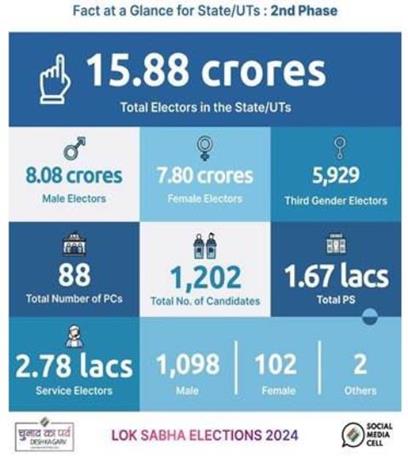Voter Turnout Varied Across States in Second Phase of Lok Sabha Elections 2024
Uttar Pradesh saw the lowest turnout at 54.85%, which may suggest voter fatigue or a complex electoral landscape in this crucial battleground state.
The second phase of the 2024 Lok Sabha elections, held across 88 constituencies spanning 13 states and Union territories, concluded with a commendable voter turnout of nearly 64%. This phase was notably characterized by peaceful voting conditions and robust participation from a cross-section of the electorate, indicating the vibrancy and maturity of Indian democracy.
and Union territories, concluded with a commendable voter turnout of nearly 64%. This phase was notably characterized by peaceful voting conditions and robust participation from a cross-section of the electorate, indicating the vibrancy and maturity of Indian democracy.
This round of polling, crucial in the sequence of the multi-phased electoral process, marked a significant increase in voter engagement in several areas, including regions that witnessed polling for the first time. The Election Commission’s report highlights the enthusiastic participation of a diverse demographic—from newlyweds and senior citizens to tribals and IT professionals—across varied weather conditions.
Highs and Lows of Voter Turnout
Among the states, Tripura saw the highest turnout, with 79.46%, signalling strong political engagement in the northeastern state. Conversely, Uttar Pradesh recorded the lowest at 54.85%, reflecting a more complex electoral environment or possible voter fatigue in this key battleground state.
In the second phase of the 2024 Lok Sabha elections, polling took place across diverse regions, covering all 20 seats in Kerala, 14 of the 28 in Karnataka, and 13 in Rajasthan, with 8 seats each in Maharashtra and Uttar Pradesh. Other states saw varied polling, including Madhya Pradesh (6 seats), Assam and Bihar (5 each), Chhattisgarh and West Bengal (3 each), and one seat each in Manipur, Tripura, and Jammu and Kashmir. Notably, Tripura recorded the highest voter turnout at 79.46%, followed closely by Manipur with 77.32%, while Chhattisgarh and West Bengal registered 73.05% and 71.84%, respectively.
Karnataka reported a 69.23% voter turnout across its 14 constituencies, with urban areas like Bengaluru showing lower participation, ranging from 52.81% to 54.42%. Rajasthan’s voter turnout for all 25 seats reached 61.60%, slightly down from the previous election. Jammu saw a robust turnout of nearly 72%, while Bihar and Uttar Pradesh had voter turnouts of 55.08% and 54.85%, respectively.
Kerala concluded its polling with a provisional 65.91%, likely to increase due to late voters, contrasting with a 77.84% turnout in 2019. Madhya Pradesh and Maharashtra recorded voter turnouts of around 57.88% and 57.83%, respectively.
This variance in voter turnout can be attributed to multiple factors, including local issues, the effectiveness of electoral mobilization by political parties, and the overall sentiment towards governance. Such disparities underscore the regional nuances of Indian politics, where each state often mirrors a different facet of the electoral mosaic.
Technology and Security Enhancements Ensure Smooth Polling
The Election Commission, led by Chief Election Commissioner Shri Rajiv Kumar, monitored the polling process closely. The deployment of webcasting in over 1 lakh polling stations enhanced transparency and bolstered security, making it conducive for voters to cast their ballots without fear of coercion or unrest.
Stringent security measures ensured the peaceful conduct of the polls, ensuring that law and order were maintained and voters felt safe to exercise their franchise.
Cultural Celebrations and Inclusivity at the Booths
The polling also witnessed cultural expressions, with voters and officials donning traditional attire, transforming the polling booths into sites of artistic celebration. This aspect of the electoral process, often called “Chunav ka Parv” (the festival of election), highlights the deep-rooted cultural engagement and the celebratory nature of democratic exercises in India.
Special arrangements were made to accommodate the needs of vulnerable groups, including older people, persons with disabilities (PwDs), and first-time voters, showcasing the inclusive approach of the election management body. PwD voter Vijay Sahu was notable among the voters who cast his vote in Khajuraho, Madhya Pradesh, using a motorized tricycle, symbolizing the empowered participation of differently-abled citizens in the democratic process.
Celebrity Influence and Youth Engagement
The participation of cricketing legends like Anil Kumble, Rahul Dravid, and Javagal Srinath, who were seen voting in Bangalore, highlights the role of public figures in advocating for civic engagement. Their presence at polling stations and the display of their inked fingers served as a powerful message to the youth, emphasizing the importance of participating in the electoral process.
Expansion of Polling Infrastructure
A significant development in this phase was the setting up polling booths in 46 new villages in the Bastar and Kanker constituencies of Chhattisgarh, facilitating voting in these villages for the first time in a Lok Sabha election. This expansion not only brought democracy closer to remote areas but also highlighted the Election Commission’s commitment to making voting more accessible.
The second phase of the 2024 Lok Sabha elections has set a benchmark for peaceful polling and voter turnout and reflected the inclusive and festive nature of Indian democracy. As India progresses through the remaining phases of this election, the continued engagement of voters, the role of technology in ensuring a fair process, and the celebration of electoral participation will be crucial in shaping the country’s political landscape.
